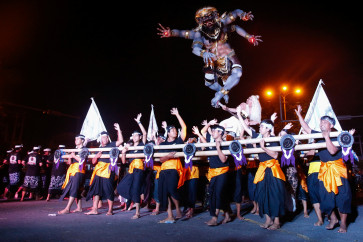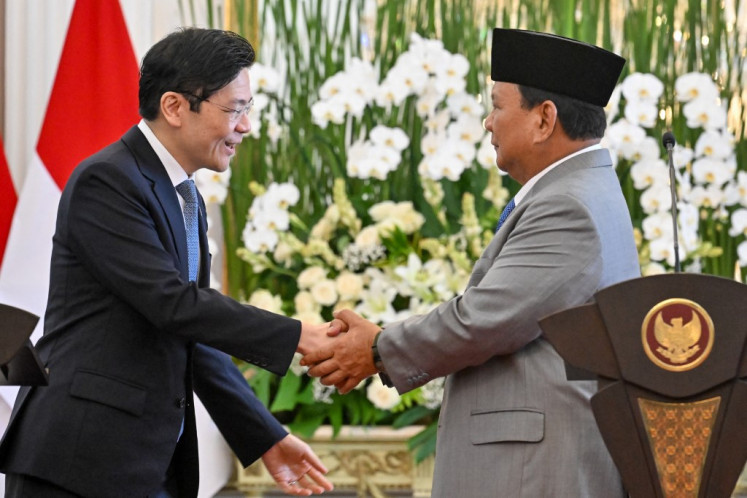Chiang Rai cave rescue and Thai’s mythical realm
Living as a foreigner in Chiang Rai, the northernmost part of Thailand, I realized that this city is surrounded by a strong sense of “something” that, at first, I could not explain but feel
Change text size
Gift Premium Articles
to Anyone

L
iving as a foreigner in Chiang Rai, the northernmost part of Thailand, I realized that this city is surrounded by a strong sense of “something” that, at first, I could not explain but feel. This sense became clearer as I followed the rescue of the trapped soccer team, the Wild Boars or moo pa, in the Tham Luang Nang Non caves in Mae Sai, Chiang Rai.
For weeks, 12 boys and their coach were trapped inside a dark cave with extremely limited access to food, drinking water and air. After soccer practice, the group entered the cave, which they had visited earlier, with enough supplies for a five-hour trek.
As the sudden monsoon rains began, water flooded several chambers and blocked the exit. On June 23, parents reported their sons missing. Aside from the boys’ handprints and belongings left at the mouth of the cave, nothing else had been found.
Tham Luang Nang Non means “the reclining lady’s big cave”, believed to be inhabited by Jao Mae Nang Non, a princess of the Lanna Kingdom, who, as the legend goes, was impregnated by her commoner lover and committed suicide after she was forbidden to be with him.
She sought refuge inside the cave while fleeing the king, her father, until her lover returned with some food, but the man was killed by the king’s soldiers, as writers recite.
She stabbed herself to death. Her reclining body became the mountains, her blood became the famous Mae Nam Mae Sai River and her genitals, the cave. She is now the sacred spirit ruler of Chiang Rai’s mountainous area.
Southeast Asia is rich with myths and supernatural explanations behind the origin of a place, including mountains. Influenced by Brahmin, Buddhist and animist traditions, in Thailand caves are believed to have spiritual powers.
Caves are places of danger, but also of possibility. To find the lost boys, Thais sought answers and help from mythical creatures. According to reports they came to a shrine near the cave, prostrated, lighted candles and prayed in front of a statue of a young woman wearing a pink traditional outfit, surrounded by flowers and other offerings — the princess.
Before the boys were found alive, locals told me they believed the princess’ spirit played a role in their disappearance. The locals said they needed to communicate with the cave’s ruler to find the boys. They asked for help from a monk from Tachilek district, Myanmar, a border town with Mae Sai, who was believed to be the reincarnation of the princess’ lover. As the monk communicated with the princess, he said the boys and the coach were alive, however, the princess would ask in return that a person stay with her.
More and more senior monks and holy people arrived to hold vigils at the cave. Thai authorities appealed to the cave’s spirits by setting up shrines, burning incense, offering food and drinks, including giving away a boiled boar’s head, a symbol of the soccer team’s name.
___________________
They believed the princess’ spirit played a role in their disappearance.
Prime Minister Prayuth Chan-o-cha asked the blessings of the supreme patriarch of the sangha, the monks’ council and a mass prayer vigil was also organized in Bangkok.
It was then suggested that to locate the soccer team and bring them to safety, the rescuers must attempt to have representations of the symbol of the Buddha to overcome the spirits’ power. Divers slipped Buddhist bracelets on their wrists, a hermit stood beside the road leading to the cave, locals asked for forgiveness for any wrongs against nature and asked the spirits to release the children. Their prayers sounded like “please, forest spirits, please protect the children”.
I had goosebumps as I heard that the boys and the coach were finally found after over two weeks trapped in a far corner of the cave … alive. They even smiled at the camera brought by British divers, accompanied by Thai Navy SEALS. Days later, the world followed the heroic and dramatic rescue story to bring the children out from the cave.
But I had more goosebumps as I heard that the Thai Navy SEALS lost one of their best, officer Saman Gunan, who lost consciousness during attempts to save the boys. The news reminded me of the locals reciting the princess’s request.
Now that all Chiang Rai’s moo pa are rescued and pulled to safety, I am impressed by how Thai people combined traditional spirituality with modern technology to solve a problem together. Thailand’s cave rescue has sparked not only celebrations for this “mission impossible”, but also shows humanity at its finest. This incident also reminds us that sometimes we need our local culture and traditional beliefs to understand our own environment.
As the SEALS shouted to whip up morale to everyone who helped the mission — Hooyah!
____________________________
The writer is an Indonesian lecturer of ASEAN Studies at the School of Social Innovation, Mae Fah Luang University, Chiang Rai.









